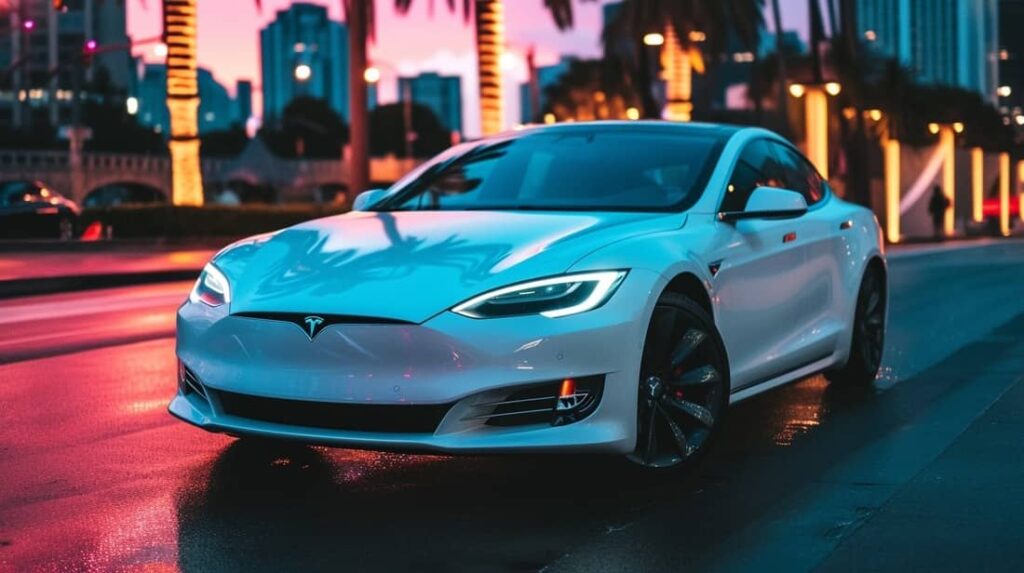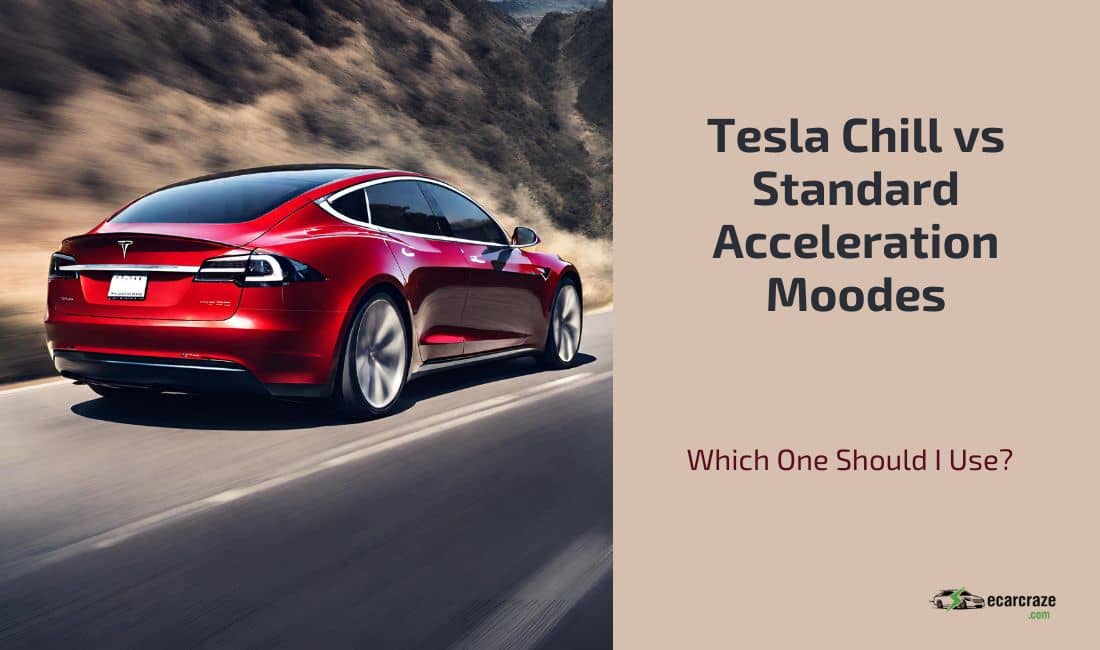A few years ago, Tesla did software updates and introduced one new driving mode – Chill acceleration mode. This joined the existing Standard mode and others like Sports and Ludicrous to provide more flexibility. So, Tesla Chill vs Standard, which mode is right for you?
The chill mode is ideal if you want to maximize range and efficiency through acceleration limiting. The Standard mode offers a balance of performance and efficiency. Chill mode is perfect for long highway commutes, slippery roads, and other scenarios where acceleration is not needed. Its counterpart suits daily commuting and typical driving scenarios.
In this article, we’ll break down all the key differences between the two modes. We will tell you which driving mode to use for efficiency, range, and so forth.
The sentence is mostly correct, but it could be slightly improved for clarity and conciseness. Here’s a revised version:
An Overview of Tesla Chill vs Standard
Here is a table illustrating the differences between these two driving modes:
| Chill | Comparison aspects | Standard |
| Smooth acceleration | Driving experience | Default acceleration |
| 7.5 seconds | Acceleration (O to 60 mph) | 2.9 to 3.5 seconds, depending on the model |
| Not capped | Top speed | Not capped |
| No significant heating | Battery heating | Normal heating |
| Low | Battery Usage | Standard |
| Long trips, driving with passengers, slippery terrain, traffic jams | Best For | Daily driving, winding roads, clear highways, Tesla acceleration |
If you want to learn about Tesla’s stopping modes, check out our guide on Creep vs. Roll stopping modes.
Tesla Chill Mode Explained
The Chill mode is designed to offer a smooth driving experience. When activated, the acceleration profile of the vehicle is significantly tamed. So instead of those neck-snapping, instant accelerations that Teslas are known for, you have a gradual speed gain.
This driving mode has the following characteristics:
- Availability: Chill acceleration mode is available as a selectable driving mode on all consumer Tesla vehicles. This includes Model S, Model 3, Model X, and Model Y.
- Acceleration: In this mode, acceleration is intentionally limited. The torque and power output are also dialed back. The result is a slower pedal response. It takes 7.5 seconds for all models to come from a standstill to 60 mph.
- Driving experience: The tempered acceleration creates a smoother, more relaxed driving experience. It removes the sensation of being “pinned to your seat” when you accelerate hard.
- Battery heating: Teslas preheat their batteries to optimum operation when first starting. This is to maximize their performance. In chill mode, this preheating is disabled, as you do not need any performance. So, batteries start cooler than normal.
- Energy efficiency: By limiting the power output and not preheating batteries, Chill mode reduces energy consumption and strain on batteries, The conserved energy translates directly to increased range per charge.
- Top speed: Chill mode does not limit the top speed. Your Tesla will still reach its maximum rated speed. However, it will take longer to reach that speed due to the reduced acceleration and power output.
Tesla Standard Acceleration Mode Explained
This is the default acceleration setting that balances performance and efficiency. Unlike Chill mode, here nothing is tempered. The power output and torque are not limited.
This driving mode has the following characteristics:
- Availability: As mentioned, this is the default acceleration profile that comes activated on all Teslas that you will buy. So it’s available on all models.
- Acceleration: There is no limit imposed on acceleration rated. The vehicle could achieve its maximum rated acceleration time depending on the model and configuration. The accelerator response is sharp and instant.
- Driving experience: The acceleration feel while on the standard mode is best described as brisk but moderate. It delivers smooth, robust acceleration that is spirited but not extreme.
- Battery heating: The battery will be preconditioned to the standard operating temperatures when the vehicle is first started. This will allow for good acceleration and performance. However, this mode does not warm up the batteries to the sweet spot that the sports mode does.
- Energy efficiency: This mode optimizes for a balance between acceleration performance and battery efficiency. It avoids excess power draw through things like not heating the batteries to the ideal temperature.
- Top speed: Like acceleration, there are no caps on top speed. The vehicle will reach its rated top speed.
Tesla Chill vs Standard Acceleration Moodes: Which One Should I Use?

Here are factors that will help you make an informed choice:
1. Passengers and Pets
When carrying passengers like children or the elderly, the muted accelerator response and reduced g-forces of Chill mode are ideal. The neck-snapping acceleration of Teslas is not ideal for pets either. The sudden launch could potentially injure them if they are not seated well or prepared.
When alone or you have passengers who are prepared for the crazy acceleration that Teslas have, you can use the standard mode.
2. Driving Conditions
Here is a breakdown of the driving conditions where each mode excels:
# Slippery conditions and Off-road:
Chill mode wins here as it helps avoid wheel slip and maintains control in low traction conditions like snow, ice, rain, and off-road. The gradual torque buildup prevents tires from spinning fast and losing grip.
Standard mode, on the other hand, offers the normal power Teslas are known for. In slippery conditions, you do not need this much torque. Hence, you are better off with the Chill mode.
# Night driving:
In low light conditions, you want a setting that gives you gradual acceleration. This is the Chill mode, as it allows for more time to assess road hazards since the acceleration and speed build-up is gradual. The responsiveness of standard mode is just too high for conditions where your vision is not optimum.
# High-traffic areas:
Chill mode takes it again in these conditions. The Standard mode has a more responsive pedal. This would result in jerky driving when in a traffic jam.
# Open highways and roads:
Here, you would want the responsiveness and performance that the Standard mode offers. Chill mode has a slow torque build-up, which is not needed when you have a clear road ahead of you.
# Winding roads:
Standard mode allows you to hit apexes on curvy roads with its unrestricted power. Chill mode will struggle to exit tight turns on a hill due to power limitations.
3. Efficiency and Range
Chill mode reduces power output and disables the warming of the battery. The result is increased range, which could make a difference on long trips.
Standard, on the other hand, provides a good middle ground for range and performance. But when range anxiety is your major factor, nothing beats Chill for efficient batteries.
4. Driving Experience Preference
If you want more relaxed and smooth driving, Chill mode has got you covered. It does not have crazy accelerations.
For moderate performance and acceleration, choose the Standard mode as it has no limitations.
5. Towing or Heavy Load
Towing puts a great strain on your motors and battery system compared to unloaded driving. Chill mode is your best bet to unload some of this strain. It reduces torque output and limits acceleration. Hence, you will have less power drawn, and the motors won’t be overtaxed.
Also, with a heavy load, acceleration needs to be gradual to avoid trailer sway or loss of control. This would also prevent the nose of your car from lifting since there is no instant application of full power.
Using Tesla Standard Mode here means you have unrestricted acceleration when towing. This leads to the trailer swaying or fishtailing due to too much instant torque. This could also cause the vehicle’s nose to pitch up.
6. Battery Lifespan
The lower power output and reduced torque in Chill mode delivery minimize strain on the batteries. There are no high discharge rates, hence reduced electrical strain and longer lifespan.
Standard mode preconditions the batteries by heating them. It also has unrestricted discharge rates. This generates more heat and battery wear over time compared to Chill.
FAQs
Here are answers to questions that will come up as you read:
You can switch between the modes using the vehicle’s touchscreen. Tap Controls > Pedals and Steering > Driving > Acceleration. Select either “Chill” or “Standard.” You can switch the mode at any time, be it while driving or stopping.
Sports mode will provide you with the best performance compared to Standard mode. You can further enhance the sports mode by selecting Ludicrous+ or Launch modes. The modes reduce battery heating time and increase the torque by up to 60%.
No. For regenerative braking, you would have to select that manually on the vehicle’s controls. Regardless of which acceleration mode you are in, you are free to have high, medium, or low regenerative braking.
Final Verdict: Which Mode Should You Use?
The choice between Tesla Chill and Standard acceleration modes shows how flexible these vehicles are when it comes to driving experience and comfort. If you want a brisk acceleration for the commute to your work, the Standard mode will be there for you.
Chill is the way to go if you need to squeeze every last mile out of a charge. It also has a softer pedal response and capped acceleration. These are overly conservative for some, but others will appreciate the smooth, relaxed ride the mode provides.

I am an experienced guide in electric mobility, offering clear and expert guidance for those venturing into the world of electric vehicles.
Through collaborations, research, and hands-on experience, I navigate readers through the evolving landscape of smart automobile technologies and the significance of renewables.

